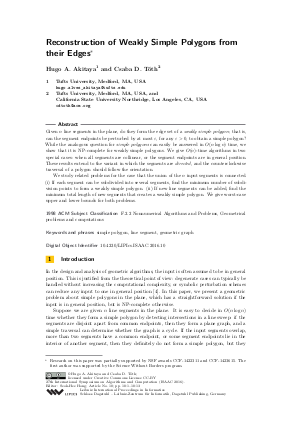Reconstruction of Weakly Simple Polygons from their Edges
Authors Hugo A. Akitaya, Csaba D. Tóth
-
Part of:
Volume:
27th International Symposium on Algorithms and Computation (ISAAC 2016)
Part of: Series: Leibniz International Proceedings in Informatics (LIPIcs)
Part of: Conference: International Symposium on Algorithms and Computation (ISAAC) - License:
 Creative Commons Attribution 3.0 Unported license
Creative Commons Attribution 3.0 Unported license
- Publication Date: 2016-12-07
File

PDF
LIPIcs.ISAAC.2016.10.pdf
- Filesize: 0.53 MB
- 13 pages
Document Identifiers
Subject Classification
Keywords
- simple polygon
- line segment
- geometric graph
Metrics
- Access Statistics
-
Total Accesses (updated on a weekly basis)
0PDF Downloads0Metadata Views
Abstract
Given n line segments in the plane, do they form the edge set of a weakly simple polygon; that is, can the segment endpoints be perturbed by at most epsilon, for any epsilon > 0, to obtain a simple polygon? While the analogous question for simple polygons can easily be answered in O(n log n) time, we show that it is NP-complete for weakly simple polygons. We give O(n)-time algorithms in two special cases: when all segments are collinear, or the segment endpoints are in general position. These results extend to the variant in which the segments are directed, and the counterclockwise traversal of a polygon should follow the orientation. We study related problems for the case that the union of the n input segments is connected. (i) If each segment can be subdivided into several segments, find the minimum number of subdivision points to form a weakly simple polygon. (ii) If new line segments can be added, find the minimum total length of new segments that creates a weakly simple polygon. We give worst-case upper and lower bounds for both problems.
Cite As Get BibTex
Hugo A. Akitaya and Csaba D. Tóth. Reconstruction of Weakly Simple Polygons from their Edges. In 27th International Symposium on Algorithms and Computation (ISAAC 2016). Leibniz International Proceedings in Informatics (LIPIcs), Volume 64, pp. 10:1-10:13, Schloss Dagstuhl – Leibniz-Zentrum für Informatik (2016)
https://doi.org/10.4230/LIPIcs.ISAAC.2016.10
BibTex
@InProceedings{akitaya_et_al:LIPIcs.ISAAC.2016.10,
author = {Akitaya, Hugo A. and T\'{o}th, Csaba D.},
title = {{Reconstruction of Weakly Simple Polygons from their Edges}},
booktitle = {27th International Symposium on Algorithms and Computation (ISAAC 2016)},
pages = {10:1--10:13},
series = {Leibniz International Proceedings in Informatics (LIPIcs)},
ISBN = {978-3-95977-026-2},
ISSN = {1868-8969},
year = {2016},
volume = {64},
editor = {Hong, Seok-Hee},
publisher = {Schloss Dagstuhl -- Leibniz-Zentrum f{\"u}r Informatik},
address = {Dagstuhl, Germany},
URL = {https://drops.dagstuhl.de/entities/document/10.4230/LIPIcs.ISAAC.2016.10},
URN = {urn:nbn:de:0030-drops-67795},
doi = {10.4230/LIPIcs.ISAAC.2016.10},
annote = {Keywords: simple polygon, line segment, geometric graph}
}
Author Details
References
-
Hugo A. Akitaya, Greg Aloupis, Jeff Erickson, and Csaba Tóth. Recognizing weakly simple polygons. In Proc. 32nd Int. Sympos. Comput. Geom., volume 51 of LIPIcs, Dagstuhl, 2016.

-
Hugo A. Akitaya and Csaba D. Tóth. Reconstruction of weakly simple polygons from theirs edges. Preprint, arXiv, 2016.

-
Gill Barequet, Craig Gotsman, and Avishay Sidlesky. Polygon reconstruction from line cross-sections. In Proc. 18th Canadian Conf. Comput. Geom., Kingston, ON, 2006.

-
Mark de Berg, Otfried Cheong, Marc van Kreveld, and Mark Overmars. Computational Geometry: Algorithms and Applications. Springer-Verlag, Berlin, 3rd edition, 2008.

-
Mark de Berg and Amirali Khosravi. Optimal binary space partitions in the plane. Internat. J. Comput. Geom. Appl., 22(3):187-205, 2012.

-
Therese Biedl, Stephane Durocher, and Jack Snoeyink. Reconstructing polygons from scanner data. Theoret. Comput. Sci., 412(32):4161-4172, 2011.

-
Hsien-Chih Chang, Jeff Erickson, and Chao Xu. Detecting weakly simple polygons. In Proc. 26th ACM-SIAM Symposium on Discrete Algorithms, pages 1655-1670. SIAM, 2015.

-
Bernard Chazelle. Triangulating a simple polygon in linear time. Discrete Comput. Geom., 6(3):485-524, 1991.

-
Pier Francesco Cortese, Giuseppe Di Battista, Maurizio Patrignani, and Maurizio Pizzonia. On embedding a cycle in a plane graph. Discrete Math., 309(7):1856-1869, 2009.

-
Andreas Darmann, Janosch Döcker, and Britta Dorn. On planar variants of the monotone satisfiability problem with bounded variable appearances. Preprint, arXiv:1604.05588, 2016.

-
Yann Disser, Matúš Mihalák, and Peter Widmayer. A polygon is determined by its angles. Comput. Geom. Theory Appl., 44(8):418-426, 2011.

-
Michael Formann and Gerhard J. Woeginger. On the reconstruction of simple polygons. Bulletin EATCS, 40:225-230, 1990.

-
Carl Hierholzer and Chr Wiener. Über die Möglichkeit, einen Linienzug ohne Wiederholung und ohne Unterbrechung zu umfahren. Mathematische Annalen, 6(1):30-32, 1873.

-
Michael Hoffmann and Csaba D Tóth. Segment endpoint visibility graphs are Hamiltonian. Comput. Geom. Theory Appl., 26(1):47-68, 2003.

-
Klaus Jansen and Gerhard J Woeginger. The complexity of detecting crossingfree configurations in the plane. BIT Numerical Mathematics, 33(4):580-595, 1993.

-
Joseph O’Rourke. Uniqueness of orthogonal connect-the-dots. In Godfried T. Tousaint, editor, Computational Morphology, pages 97-104. North-Holland, 1988.

-
David Rappaport. Computing simple circuits from a set of line segments is NP-complete. SIAM J. Comput., 18(6):1128-1139, 1989.

-
Csaba D Tóth. Connectivity augmentation in planar straight line graphs. European J. Combin., 33(3):408-425, 2012.

-
Masatsugu Urabe and Mamoru Watanabe. On a counterexample to a conjecture of Mirzaian. Comput. Geom. Theory Appl., 2(1):51-53, 1992.

